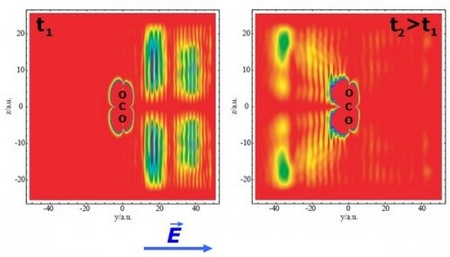Accueil > Équipes scientifiques > Dynamiques et Interactions : Rayonnement, Atomes, Molécules (DIRAM) > Processus moléculaires contrôlés par des champs laser intenses > Femtosecond Electron Diffraction
Femtosecond Electron Diffraction
This project is part of the ongoing collaboration with Christian Cornaggia, here with the "Image Femto" ANR Project. The idea behind this electron diffraction technique is the rescattering mechanism. We suggest controlling this mechanism to use the electron as an ultrafast diffraction probe. The very nature of the rescattering mechanism provides a femtosecond temporal resolution and by carefully choosing the laser parameters, it is possible to adjust the wavelength of the electron so it corresponds to the molecular internuclear distance.
On the experimental front, the study of the photoelectron spectra coming from non aligned molecules showed that the molecular specificities can be detected in the angular distributions [1] and in the electron signal coming from the rescattering mechanism [2]. On the theoretical front, early results on CO![]() using a 2D "soft core" potential of an aligned molecule in interactio with a 800-nm and 1-optical-cycle laser pulse make us believe that the geometrical structure of the molecule appears in the photoelectron spectra. Fig. 1 shows the electronic wavefunction of CO
using a 2D "soft core" potential of an aligned molecule in interactio with a 800-nm and 1-optical-cycle laser pulse make us believe that the geometrical structure of the molecule appears in the photoelectron spectra. Fig. 1 shows the electronic wavefunction of CO![]() with the electric field E of the laser pulse at two different times, t
with the electric field E of the laser pulse at two different times, t![]() and t
and t![]() > t
> t![]() . At t
. At t![]() , the electronic wavefunction is already away from the molecule and is coming back to the parent ion, due to the direction of the electric field. At t
, the electronic wavefunction is already away from the molecule and is coming back to the parent ion, due to the direction of the electric field. At t![]() , the electron passed the nuclei and has therefore interacted with it. The interference fringes that have appeared may contain information concerning the molecular internuclear distance or the symmetry of the system at the moment of the rescattering.
, the electron passed the nuclei and has therefore interacted with it. The interference fringes that have appeared may contain information concerning the molecular internuclear distance or the symmetry of the system at the moment of the rescattering.

Figure 1. CO![]() electronic wavefunction as a function of spatial coordinates y and z at 2 different times t
electronic wavefunction as a function of spatial coordinates y and z at 2 different times t![]() and t
and t![]() .
.
[1] C. Cornaggia, Phys. Rev. A 78, 041401® (2008)
[2] C. Cornaggia , J. Phys. B 42, 161002 (2009)
Dans la même rubrique :
- Processus moléculaires contrôlés par des lasers intenses : Dynamiques électronique et nucléaire
- Processus moléculaires en présence de champs intenses : Résonances et contrôle
- Explosion coulombienne de induite par une impulsion laser intense sub-10 fs
- Diffraction électronique femtoseconde
- Dynamique électronique et nucléaire de molécules exposées à des impulsions laser ultra-brèves et intenses


